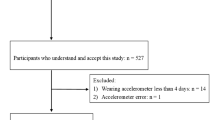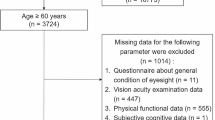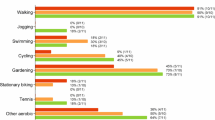Abstract
Background
Children with visual impairment (VI) tend to maintain the insufficient physical activity (PA) engagement and excessive sedentary behavior (SB) that could elevate health risks of various domains. Anxiety have been shown to correlate with PA and SB in general population, whereas the longitudinal or temporal relationships between PA, SB, and anxiety have yet to be examined in children with VI. Therefore, the primary purpose of this study is to investigate the bidirectional relationships between these variables over time.
Methods
72 Chinese children with VI (mean age = 14.65 ± 3.34 years) recruited from a special school for individuals with VI participated in this study. Moderate-to-vigorous physical activity (MVPA) and SB were assessed using ActiGraph GT3x + accelerometers across seven consecutive days. Anxiety was assessed by a self-reported questionnaire. Cross-lagged panel models were employed to examine the potential bidirectional relationships between PA, SB, and anxiety at baseline (T1) and 12-week follow-up (T2).
Results
T1 anxiety significantly predicted T2 MVPA only in children with low vision (β= -0.30, p = 0.01). In additional, children with blindness showed a cross-lagged effect of T1 MVPA on T2 anxiety (β=-0.29, p = 0.02). Lastly, anxiety significantly predicted T2 SB in the total sample (β = 0.21, p = 0.04) and children with low vision (β = 0.42, p < 0.01).
Conclusion
The relationships between PA, SB and anxiety were not bidirectional in children with VI. It is suggested that higher anxiety predicted less PA and more SB in children with low vision.



Similar content being viewed by others
Data Availability
The data that support the findings of this study are available from the corresponding author, upon reasonable request.
References
Ainsworth, B. E., Haskell, W. L., Herrmann, S. D., Meckes, N., Bassett, D. R., Tudor-Locke, C., Greer, J. L., Vezina, J., Whitt-Glover, M. C., & Leon, A. S. (2011). 2011 Compendium of Physical Activities: a second update of codes and MET values. Medicine And Science In Sports And Exercise, 43(8), 1575–1581
Ajzen, I. (1991). The theory of planned behavior. Organizational Behavior and Human Decision Processes, 50(2), 179–211
Allen, M. S., Walter, E. E., & Swann, C. (2019). Sedentary behaviour and risk of anxiety: A systematic review and meta-analysis. Journal of Affective Disorders, 242, 5–13. https://doi.org/10.1016/J.JAD.2018.08.081
Arjmandnia, A., Samad, A. G., Sabah, V., & Ali, K. R. (2017). Investigating Social Anxiety, Self-Image, And Body Image Among Students With Visual Impairment. Journal of Child Mental Health, 4(1), 99–108
Berwal, S., Punia, P., & Dahiya, V. (2017). Effect of Gender, Degree of Impairment and Type of School on the Mental Health of Visually Impaired Students. International Journal of Special Education, 32(4), 888–900
Brian, A., Pennell, A., Haibach-Beach, P., Foley, J., Taunton, S., & Lieberman, L. J. (2019). Correlates of physical activity among children with visual impairments. Disability and Health Journal, 12(2), 328–333. https://doi.org/10.1016/j.dhjo.2018.10.007
Brunes, A., Flanders, W. D., & Augestad, L. B. (2015a). The effect of physical activity on mental health among adolescents with and without self-reported visual impairment: The Young-HUNT Study, Norway. British Journal of Visual Impairment, 33(3), 183–199. https://doi.org/10.1177/0264619615602298
Brunes, A., Flanders, W. D., & Augestad, L. B. (2015b). The effect of physical activity on mental health among adolescents with and without self-reported visual impairment: The Young-HUNT Study, Norway. British Journal of Visual Impairment, 33(3), 183–199. https://doi.org/10.1177/0264619615602298
Brunes, A., Hansen, M. B., & Heir, T. (2021). General self-efficacy in individuals with visual impairment compared with the general population. PLOS ONE, 16(7), e0254043. https://doi.org/10.1371/JOURNAL.PONE.0254043
Cao, H., Qian, Q., Weng, T., Yuan, C., Sun, Y., Wang, H., & Tao, F. (2011). Screen time, physical activity and mental health among urban adolescents in China. Preventive Medicine, 53(4), 316–320. https://doi.org/10.1016/j.ypmed.2011.09.002
Carter, T., Pascoe, M., Bastounis, A., Morres, I. D., Callaghan, P., & Parker, A. G. (2021). The effect of physical activity on anxiety in children and young people: a systematic review and meta-analysis. Journal of Affective Disorders, 285, 10–21. https://doi.org/10.1016/j.jad.2021.02.026
Carty, C., van der Ploeg, H. P., Biddle, S. J. H., Bull, F., Willumsen, J., Lee, L., Kamenov, K., & Milton, K. (2021). The first global physical activity and sedentary behavior guidelines for people living with disability. Journal of Physical Activity and Health, 18(1), 86–93. https://doi.org/10.1123/JPAH.2020-0629
Caspersen, C., Powell, K., & Christenson, G. M. (1985). Physical activity, exercise, and physical fitness: definitions and distinctions for health-related research. Public Health Report, 100(2), 126–131
Cervantes, C. M., & Porretta, D. L. (2013). Impact of After School Programming on Physical Activity Among Adolescents With Visual Impairments. Adapted Physical Activity Quarterly, 30(2), 127–146. https://doi.org/10.1123/apaq.30.2.127
Chirico, A., Lucidi, F., Galli, F., Giancamilli, F., Vitale, J., Borghi, S., la Torre, A., & Codella, R. (2020). COVID-19 Outbreak and Physical Activity in the Italian Population: A Cross-Sectional Analysis of the Underlying Psychosocial Mechanisms. Frontiers in Psychology, 11. https://doi.org/10.3389/FPSYG.2020.02100/FULL
da Silva, M. A., Singh-Manoux, A., Brunner, E. J., Kaffashian, S., Shipley, M. J., Kivimäki, M., & Nabi, H. (2012). Bidirectional association between physical activity and symptoms of anxiety and depression: The whitehall II study. European Journal of Epidemiology, 27(7), 537–546. https://doi.org/10.1007/s10654-012-9692-8
Deng, X., Zhu, Y., & Cao, Y. (2012). Characteristics and Relationship between the Mental Health and Social Anxiety of Pupils with Visual Impairment. Chinese Journal of Special Education, 11, 42–46
Desrosiers, J., Wanet-Defalque, M. C., Témisjian, K., Gresset, J., Dubois, M. F., Renaud, J., Vincent, C., Rousseau, J., Carignan, M., & Overbury, O. (2009). Participation in daily activities and social roles of older adults with visual impairment. Disability and Rehabilitation, 31(15), 1227–1234. https://doi.org/10.1080/09638280802532456
di Cagno, A., Iuliano, E., Aquino, G., Fiorilli, G., Battaglia, C., Giombini, A., & Calcagno, G. (2013). Psychological well-being and social participation assessment in visually impaired subjects playing Torball: A controlled study. Research in Developmental Disabilities, 34(4), 1204–1209. https://doi.org/10.1016/j.ridd.2012.11.010
Drake, K. L., & Ginsburg, G. S. (2012). Family Factors in the Development, Treatment, and Prevention of Childhood Anxiety Disorders. Clinical Child and Family Psychology Review, 15(2), 144–162. https://doi.org/10.1007/s10567-011-0109-0
Gale, C., & Oakley-Browne, M. (2004). Generalised anxiety disorder. Evidence-Based Mental Health, 7(2), 32–33
Gist, M., & Mitchell, T. (1992). Self-Efficacy: A Theoretical Analysis of Its Determinants and Malleability. Academy of Management Review, 17(2), 183–211. https://doi.org/10.2307/258770
Greguol, M., Gobbi, E., & Carraro, A. (2014). Physical activity practice, body image and visual impairment: A comparison between Brazilian and Italian children and adolescents. Research in Developmental Disabilities, 35(1), 21–26. https://doi.org/10.1016/J.RIDD.2013.10.020
Guinhouya, C. B., Hubert, H., Soubrier, S., Vilhelm, C., Lemdani, M., & Durocher, A. (2006). Moderate-to-Vigorous Physical Activity among Children: Discrepancies in Accelerometry-Based Cut-off Points. Obesity (Silver Spring Md), 14(5), 774–777. https://doi.org/10.1038/oby.2006.89
Gunnell, K. E., Flament, M. F., Buchholz, A., Henderson, K. A., Obeid, N., Schubert, N., & Goldfield, G. S. (2016). Examining the bidirectional relationship between physical activity, screen time, and symptoms of anxiety and depression over time during adolescence. Preventive Medicine, 88, 147–152. https://doi.org/10.1016/J.YPMED.2016.04.002
Haegele, J. A., & Zhu, X. (2021). Physical Activity, Self-efficacy and Health-related Quality of Life among Adults with Visual Impairments. Disability and Rehabilitation, 43(4), 530–536. https://doi.org/10.1080/09638288.2019.1631397
Haegele, J. A., Zhu, X., Wilson, P. B., Kirk, T. N., & Davis, S. (2021). Physical activity, nutrition, and psychological well-being among youth with visual impairments and their siblings. Disability and Rehabilitation, 43(10), 1420–1428. https://doi.org/10.1080/09638288.2019.1666926
Hallemans, A., Ortibus, E., Truijen, S., & Meire, F. (2011). Development of independent locomotion in children with a severe visual impairment. Research in Developmental Disabilities, 32(6), 2069–2074. https://doi.org/10.1016/j.ridd.2011.08.017
Houwen, S., Hartman, E., & Visscher, C. (2009). Physical activity and motor skills in children with and without visual impairments. Medicine and Science in Sports and Exercise, 41(1), 103–109. https://doi.org/10.1249/MSS.0b013e318183389d
Huang, B. (2004). An Investigation on Students’ Mental Status of Zhejiang School for the Blind. Chinese Journal of Special Education, 03, 41–44
Khouja, J., Munafò, M., Tilling, K., Wiles, N., Joinson, C., Etchells, P., John, A., Gage, S., & Cornish, R. (2017). Is increased screen time associated with the development of anxiety or depression in young people? European Psychiatry, 41, S530–S531. https://doi.org/10.1016/j.eurpsy.2017.01.719
Kozub, F. M., & Hyun-Kyoung, O. (2004). An exploratory study of physical activity levels in children and adolescents with visual impairments. Clinical Kinesiology, 58(3), 1–7. https://www.researchgate.net/publication/279761980
Kozub, F. M., Hyun-Kyoung, O., & Rider, R. A. (2005). RT3 Accelerometer Accuracy in Estimating Short Term Physical Activity in Individuals With Visual Impairments. Adapted Physical Activity Quarterly, 22(3), 265–276. https://doi.org/10.1123/apaq.22.3.265
LaMunion, S. R., Bassett, D. R., Toth, L. P., & Crouter, S. E. (2017). The effect of body placement site on ActiGraph wGT3X-BT activity counts. Biomedical Physics & Engineering Express, 3(3), 035026. https://doi.org/10.1088/2057-1976/AA777C
Lee, H. G. (2011). The mental health level of the students with visual impairments according to the degree of the participation in exercises. The Korean Journal of Visual Impairment, 27(1), 71–94
Lee, P., & Tse, C. Y. (2019). Calibration of wrist-worn ActiWatch 2 and ActiGraph wGT3X for assessment of physical activity in young adults. Gait & Posture, 68, 141–149. https://doi.org/10.1016/j.gaitpost.2018.11.023
Lemmon, C. R., Ludwig, D. A., Howe, C. A., Ferguson-Smith, A., & Barbeau, P. (2007). Correlates of Adherence to a Physical Activity Program in Young African-American Girls. Obesity (Silver Spring Md), 15(3), 695–703. https://doi.org/10.1038/oby.2007.552
Li, R., Sit, C. H. P., Yu, J. J., Duan, J. Z. J., Fan, T. C. M., McKenzie, T. L., & Wong, S. H. S. (2016). Correlates of physical activity in children and adolescents with physical disabilities: A systematic review. Preventive Medicine, 89, 184–193. https://doi.org/10.1016/j.ypmed.2016.05.029
Lindén-Boström, M., & Persson, C. (2015). Disparities in mental health among adolescents with and without impairments. Scandinavian Journal of Public Health, 43(7), 728–735. https://doi.org/10.1177/1403494815589219
Longmuir, P. E. (2000). Factors Influencing the Physical Activity Levels of Youths With Physical and Sensory Disabilities. Adapted Physical Activity Quarterly, 17, 40–53. https://doi.org/10.1123/apaq.17.1.40
Ma, W. F., Lane, H. Y., & Laffrey, S. C. (2008). A model testing factors that influence physical activity for taiwanese adults with anxiety. Research in Nursing and Health, 31(5), 476–489. https://doi.org/10.1002/nur.20279
Pinquart, M., & Pfeiffer, J. P. (2011a). Yes I Can: Self-efficacy Beliefs in Students with and without Visual Impairment.Journal of Blindness Innovation and Research, 1(3)
Pinquart, M., & Pfeiffer, J. P. (2011b). Associations of Extroversion and Parental Overprotection with Forming Relationships with Peers Among Adolescents with and without Visual Impairments. Journal of Visual Impairment & Blindness, 105(2), 96–107. https://doi.org/10.1177/0145482X1110500207
Puyau, M. R., Adolph, A. L., Vohra, F. A., & Butte, N. F. (2002). Validation and Calibration of Physical Activity Monitors in Children. Obesity Research, 10(3), 150–157. https://doi.org/10.1038/oby.2002.24
Qi, J., Xu, W. H., Wang, L. J., & Li, Q. (2020). Accelerometer-Assessed Habitual Physical Activity and Sedentary Time of Chinese Children and Adolescents with Visual Impairments. Journal of Visual Impairment & Blindness, 114(5), 421–431. https://doi.org/10.1177/0145482X20954005
Rubin, K. H., & Burgess, K. (2001). Social withdrawal and anxiety. In M.W. Vasey & M.R. Dadds (Eds.), The developmental psychopathology of anxiet (pp. 407–434)
Sabiston, C., Sedgwick, W., & Crocker, P. (2007). Social physique anxiety in adolescence: An exploration of influences, coping strategies, and health behaviors. Journal of Adolescent Research, 22(1), 78–101. https://doi.org/10.1177/0743558406294628
Selig, J. P., & Little, T. D. (2012). Autoregressive and cross-lagged panel analysis for longitudinal data. Handbook of developmental research methods (pp. 265–278). The Guilford Press
Shields, N., Synnot, A. J., & Barr, M. (2012). Perceived barriers and facilitators to physical activity for children with disability: a systematic review. British Journal of Sports Medicine, 46(14), 989. https://doi.org/10.1136/bjsports-2011-090236
Smith, L., Jackson, S. E., Pardhan, S., López-Sánchez, G. F., Hu, L., Cao, C., Vancampfort, D., Koyanagi, A., Stubbs, B., Firth, J., & Yang, L. (2019). Visual impairment and objectively measured physical activity and sedentary behaviour in US adolescents and adults: a cross-sectional study. British Medical Journal Open, 9(4), e027267. https://doi.org/10.1136/BMJOPEN-2018-027267
Stults-Kolehmainen, M. A., & Sinha, R. (2014). The effects of stress on physical activity and exercise. Sports Medicine, 44(1), 81–121. https://doi.org/10.1007/s40279-013-0090-5
Tadić, V., Pring, L., & Dale, N. (2010). Are language and social communication intact in children with congenital visual impairment at school age? Journal of Child Psychology and Psychiatry, 51(6), 696–705. https://doi.org/10.1111/J.1469-7610.2009.02200.X
Tatsuya, M., Kiyoshi, S., & Seijun, T. (1962). Study on Anxiety Tendency Diagnostic Test: Relationship between Parental Discipline and Child’s Anxiety. The Annual Report of Educational Psychology in Japan, 1, 102
Teychenne, M., Costigan, S. A., & Parker, K. (2015). The association between sedentary behaviour and risk of anxiety: A systematic review Health behavior, health promotion and society. Bmc Public Health, 15(1), 1–8. https://doi.org/10.1186/S12889-015-1843-X/TABLES/1
Tremblay, M. S., LeBlanc, A. G., Janssen, I., Kho, M. E., Hicks, A., Murumets, K., Colley, R. C., & Duggan, M. (2011). Canadian sedentary behaviour guidelines for children and youth. Applied Physiology Nutrition and Metabolism, 36(1), 59–64. https://doi.org/10.1139/H11-012/ASSET/IMAGES/LARGE/H11-012F1.JPEG
Trost, S. G., Owen, N., Bauman, A. E., Sallis, J. F., & Brown, W. (2002). Correlates of adults’ participation in physical activity: review and update. Medicine & Science in Sports & Exercise, 34(12), 1996–2001. https://doi.org/10.1097/00005768-200212000-00020
Vancampfort, D., Stubbs, B., Herring, M. P., Hallgren, M., & Koyanagi, A. (2018). Sedentary behavior and anxiety: Association and influential factors among 42,469 community-dwelling adults in six low- and middle-income countries. General Hospital Psychiatry, 50, 26–32. https://doi.org/10.1016/j.genhosppsych.2017.09.006
Ward, S., Farnsworth, C., Babkes-Stellino, M., & Perrett, J. (2011). Parental Influence and the Attraction to Physical Activity for Youths Who Are Visually Impaired at a Residential-Day School. Journal of Visual Impairment & Blindness, 105(8), 493–498. https://doi.org/10.1177/0145482X1110500805
Wong, H. B., Machin, D., Tan, S. B., Wong, T. Y., & Saw, S. M. (2009). Visual Impairment and Its Impact on Health-related Quality of Life in Adolescents. American Journal of Ophthalmology, 147(3), https://doi.org/10.1016/j.ajo.2008.09.025
World Health Organization (2014). WHO Global Disability Action Plan, 2014–2021: better health for all people with disability
World Health Organization (2020). WHO Guidelines on Physical Activity and Sedentary Behaviour
Wright, A., Roberts, R., Bowman, G., & Crettenden, A. (2019). Barriers and facilitators to physical activity participation for children with physical disability: comparing and contrasting the views of children, young people, and their clinicians. Disability and Rehabilitation, 41(13), 1499–1507. https://doi.org/10.1080/09638288.2018.1432702
Zhou, B. (1991). Mental Health Test. East China Normal University Press
Zigler, E., Bennett-Gates, D., Hodapp, R., & Henrich, C. C. (2002). Assessing Personality Traits of Individuals With Mental Retardation. American Journal on Mental Retardation, 107(3), 181–193. https://doi.org/10.1352/0895-8017(2002)107<0181:APTOIW>2.0.CO;2
Author information
Authors and Affiliations
Corresponding author
Ethics declarations
Statements and Declarations
Funding:
No funding was received for conducting this study.
Competing Interests:
The authors have no competing interests to declare that are relevant to the content of this article.
Ethics Approval:
All procedures performed in studies involving human participants were in accordance with the ethical standards of the institutional research committee and with the 1964 Helsinki Declaration and its later amendments or comparable ethical standards. The study was approved by the Ethics Committee of Shanghai University of Sport (No.102772021RT116).
Informed Consent
Statement: Informed consent was obtained from all participants involved in the study. Participation in this study was completely voluntary and anonymous.
Authors’ Contribution
Conceptualization, R.T., S.L. and C.Z.; methodology, R.T. and S.L.; formal analysis, R.T; investigation, R.T., S.L., C.B. and J.Z.; resources, C.B. and J.Z.; data curation, R.T., S.L., C.B. and C.Z.; writing—original draft preparation, R.T.; writing—review and editing, R.T. and C.Z.; supervision, J.Z. and C.Z; project administration, R.T., C.B. and C.Z. All authors have read and agreed to the published version of the manuscript.
Additional information
Publisher’s Note
Springer Nature remains neutral with regard to jurisdictional claims in published maps and institutional affiliations.
Rights and permissions
Springer Nature or its licensor holds exclusive rights to this article under a publishing agreement with the author(s) or other rightsholder(s); author self-archiving of the accepted manuscript version of this article is solely governed by the terms of such publishing agreement and applicable law.
About this article
Cite this article
Tao, R., Liang, S., Bao, C. et al. Relationships Between Physical Activity, Sedentary Behavior and Anxiety in Chinese Children with Visual Impairment: A Cross-lagged Analysis. J Dev Phys Disabil 35, 759–773 (2023). https://doi.org/10.1007/s10882-022-09879-0
Accepted:
Published:
Issue Date:
DOI: https://doi.org/10.1007/s10882-022-09879-0




